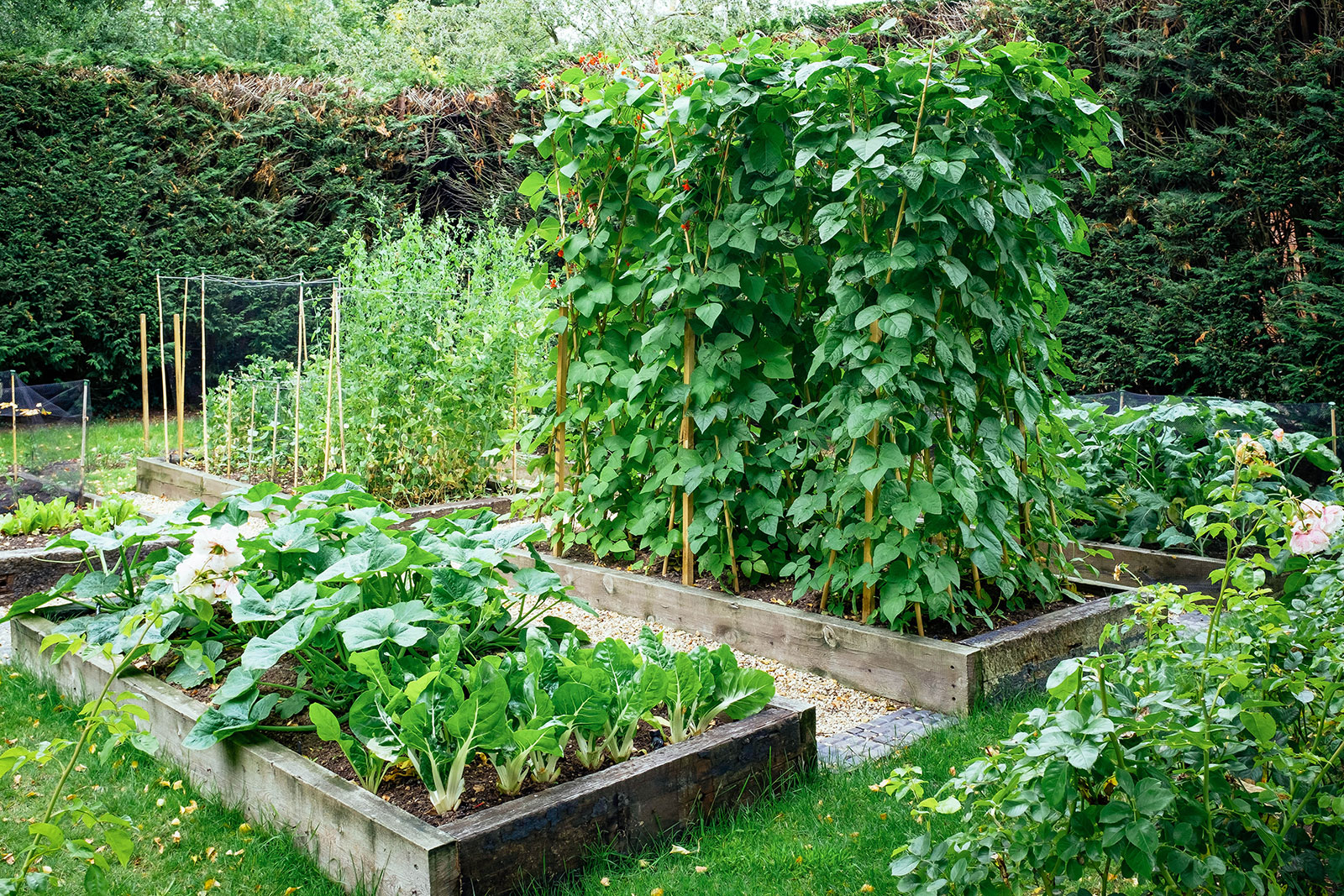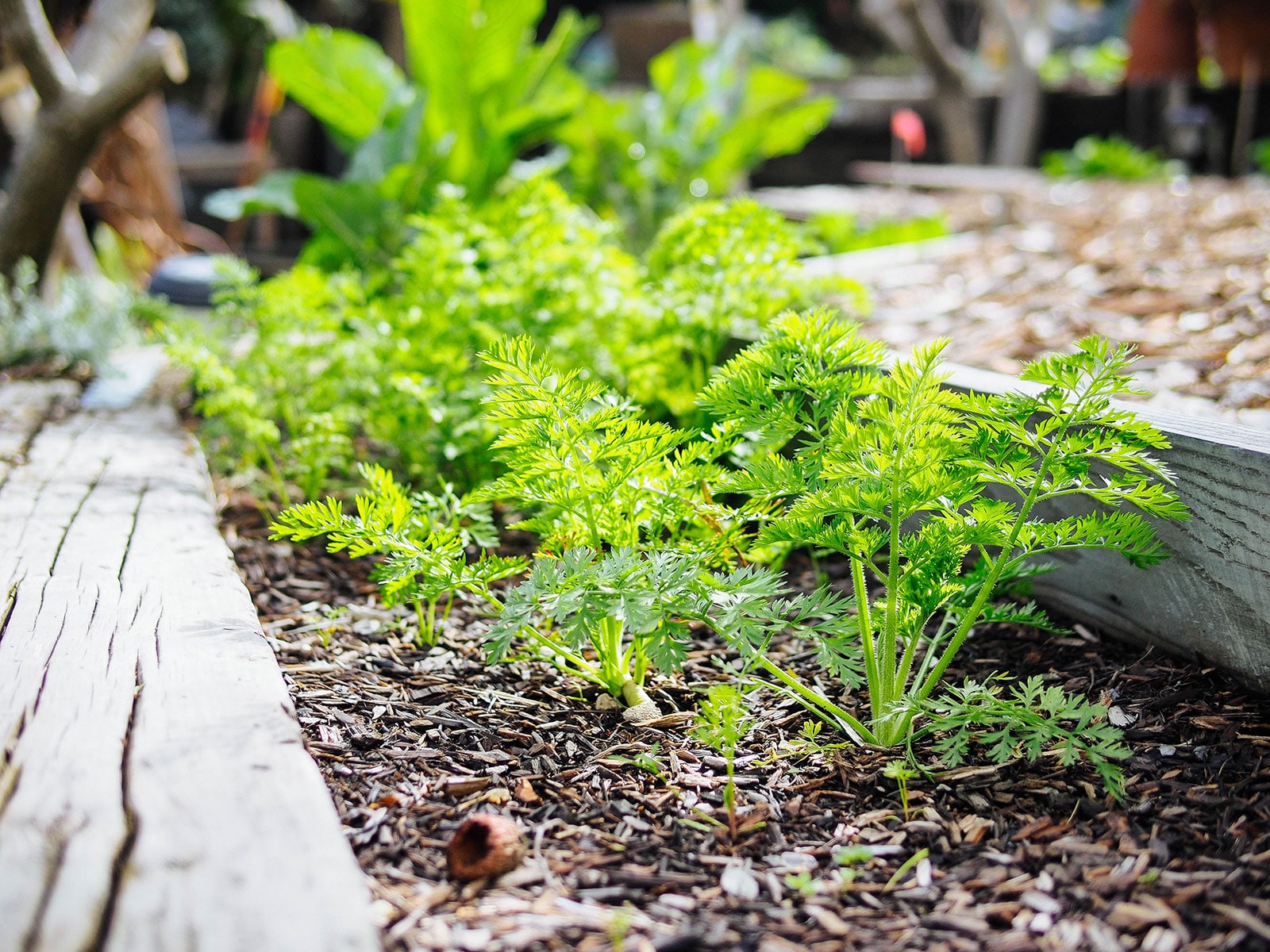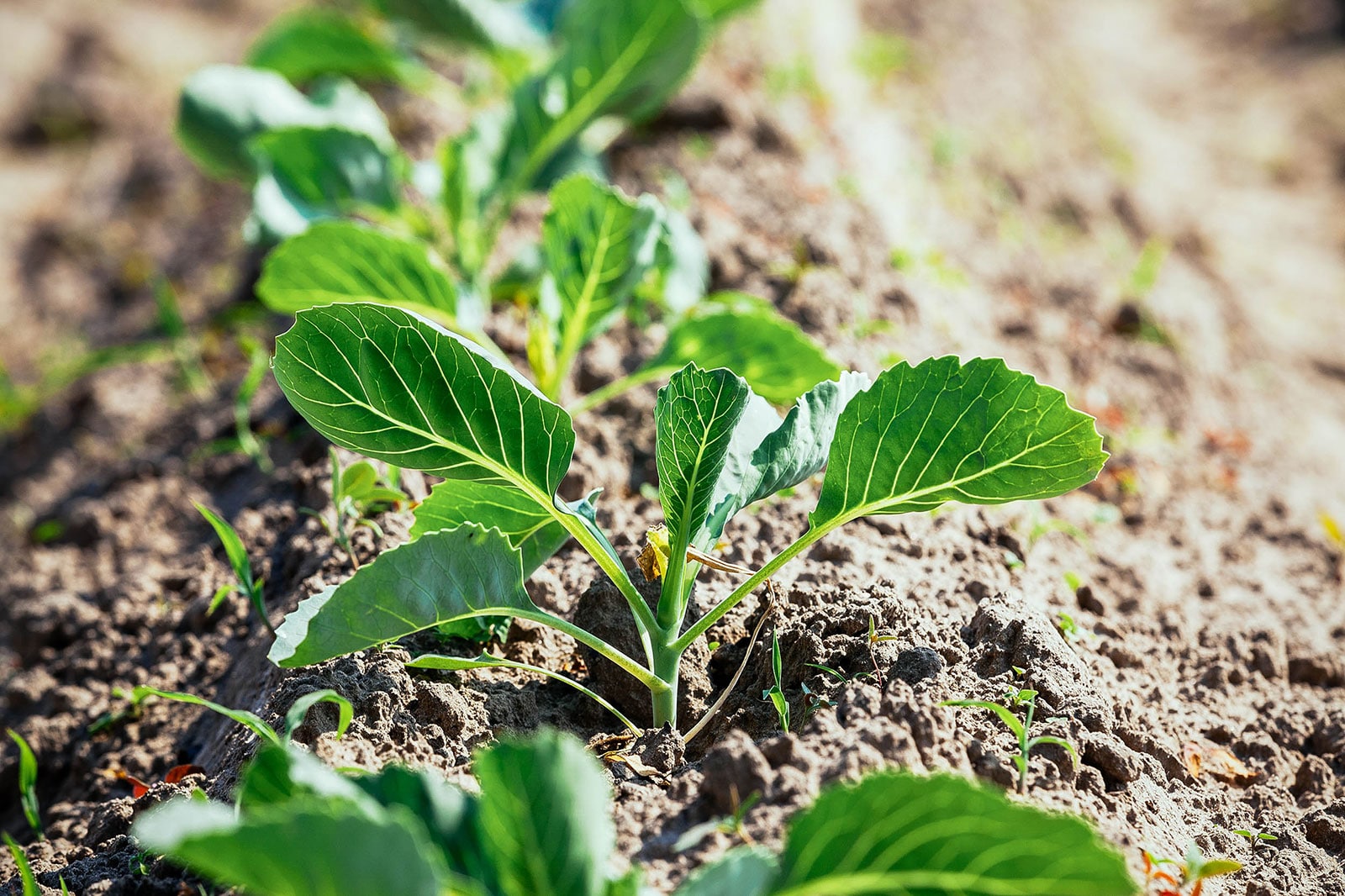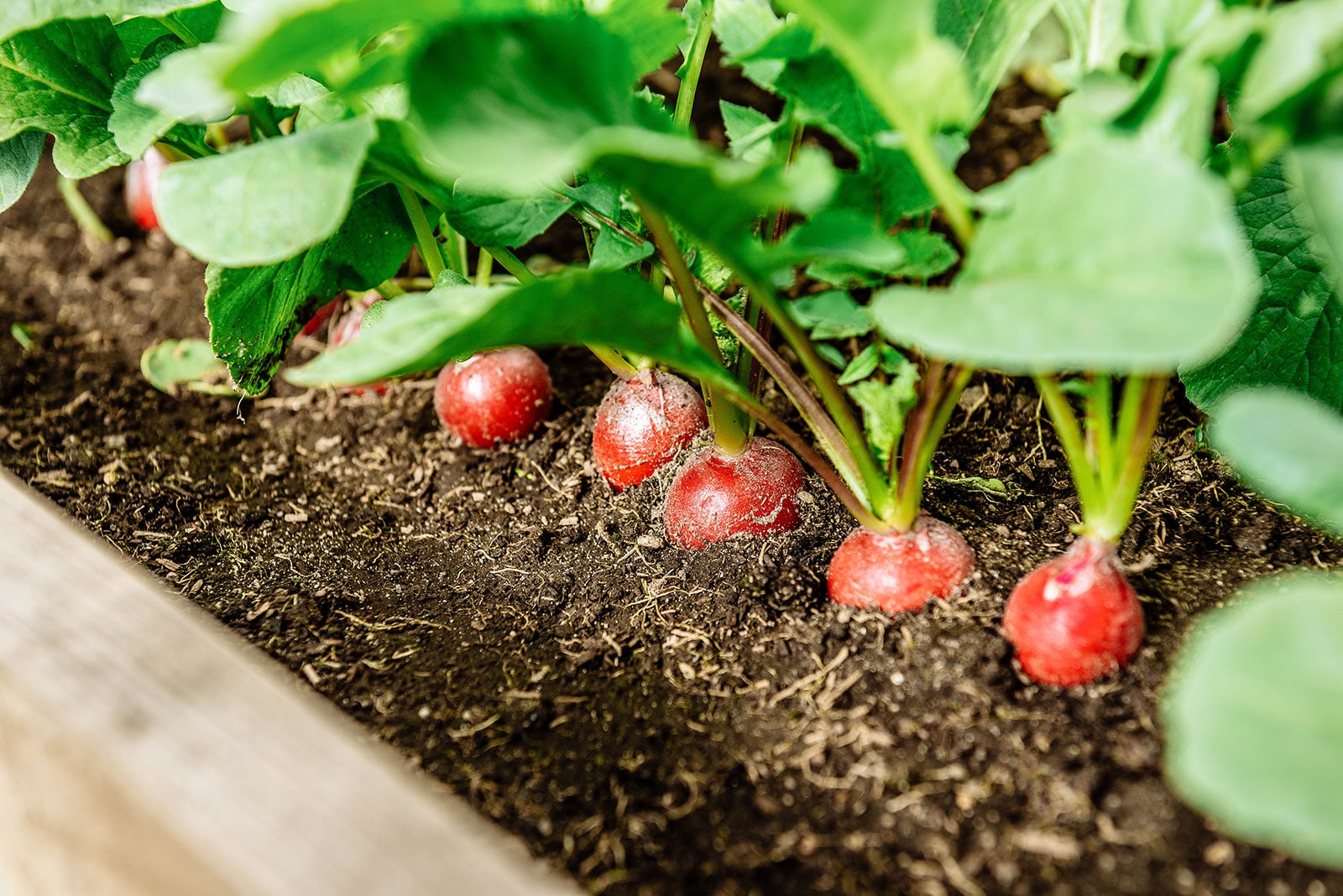When you’re planting vegetables, plant spacing is one of those things where there seems to be no definitive answer.
Why? Because different growing methods call for different spacing requirements: you’ve got square-foot gardening, tomatoes growing on Florida weave trellises, tomatoes growing inside square cages, plants in the ground vs. plants in raised beds. Pruned or not pruned? Staked or left to sprawl on the ground?
All of this makes it hard to know exactly how much room your plants need for healthy growth (and how densely you can plant before affecting how much they produce).
It doesn’t make things any easier when most seed packets give plant spacing guidelines that are specific to in-ground gardens with long rows of crops. (You’ve seen those kinds of instructions: Sow seeds 3 inches apart in rows 18 inches apart. Or, sow three seeds together, at 12 inches apart, with 24 inches between rows. I mean, whaaaaaat.)
For those of us who grow in raised beds, plant spacing looks a little differently than what the seed packets tell you. And fortunately for us, raised beds are well adapted to intensive planting, which maximizes the space you have because you’re not wasting it on foot paths.

Benefits of biointensive planting
I prefer (and personally practice) biointensive planting in my raised beds. Compared to traditional gardening methods, plants are spaced closer together (so that their leaves touch) and you can stagger your rows to fit more plants in a smaller area.
With a standard 4-foot-wide bed, you can easily reach the center, so planting intensively means you can plant in all directions and still be able to harvest.
Not only does this increase your yields, it also protects the soil by using the plants themselves as mulch for neighboring plants. When there’s less space (and less sunlight) available, weeds have fewer opportunities to take hold. Low-growing leaves also shade the soil and help with moisture retention.
How I plant
I go more in-depth on intensive planting methods (with diagrams and a printable chart) in Lazy Gardening Academy, which utilizes this and a few other simple techniques to maximize harvests in a raised bed garden with a lot less work.
Keep in mind this is not square foot gardening, which is a specialized, hyper intensive growing technique in an even smaller space.
You’ll also notice there’s no column in the chart below for row spacing because no walking paths are needed in a raised bed. The spacing suggestions are for spacing in all directions, no matter what size bed you’re working with.
I generally keep my plants about 4 inches from the edge of the bed, but following my own advice, I can pack in a lot of plants (especially if I succession plant once a spot opens up).

Spacing for transplants vs. seeds
One thing to keep in mind is if you direct sow seeds in a raised bed, you should sow them a little more densely to account for varying germination rates. Once the seedlings are a few inches tall (and it’s easier to see which ones are stronger and healthier), you can thin them to the appropriate spacing.
For example, cabbage needs 15 to 18 inches of space between plants, but you’re better off sowing seeds every 4 to 6 inches to ensure good germination. After those seedlings develop their first sets of true leaves, you can thin them out to use as microgreens or baby greens, per my spacing recommendations below, and let the rest of them keep growing without being overcrowded.
Related: How Far Apart to Plant Strawberries for the Biggest, Juiciest Berries

Plant Spacing Chart for Raised Beds
Use this plant spacing chart to help you plan how to best place your vegetables and herbs in a raised bed for maximum production.
One thing to note is that some of these plants may be perennials in your climate (and never die back in winter). If that’s the case, it’s better to space them on the upper end of these guidelines to save yourself the work of constantly pruning and dividing plants.
For gardeners outside of the United States, I also include plant spacing in centimeters.
| Vegetable | Spacing (Inches) | Spacing (Centimeters) |
|---|---|---|
| Amaranth | 6 in | 15 cm |
| Asparagus | 12 in | 30 cm |
| Artichokes | 24-36 in | 61-91 cm |
| Arugula | 4-6 in | 10-15 cm |
| Basil | 12-18 in | 30-46 cm |
| Beans, bush | 3-4 in | 8-10 cm |
| Beans, fava | 4-6 in | 10-15 cm |
| Beans, pole | 2-3 in | 5-8 cm |
| Beans, yardlong | 4-6 in | 10-15 cm |
| Beets | 3 in | 8 cm |
| Bok choy | 6-8 in | 15-20 cm |
| Broccoli | 15-18 in | 38-46 cm |
| Broccoli raab (broccoli rabe, rapini) | 4-6 in | 10-15 cm |
| Brussels sprouts | 18 in | 46 cm |
| Cabbage | 9-12 in | 23-30 cm |
| Cardoons | 18-24 in | 46-61 cm |
| Carrots | 2-3 in | 5-8 cm |
| Cauliflower | 12-16 in | 30-41 cm |
| Celeriac | 8-10 in | 20-25 cm |
| Celery | 6-8 in | 15-20 cm |
| Chard (Swiss chard) | 6-9 in | 15-23 cm |
| Chinese cabbage | 6-9 in | 15-23 cm |
| Chives | 6 in | 15 cm |
| Collards | 8-12 in | 20-30 cm |
| Corn | 8-10 in | 20-25 cm |
| Cress | 3 in | 8 cm |
| Cucumbers (trellised) | 4-6 in | 10-15 cm |
| Dandelions | 6 in | 15 cm |
| Dill | 6-10 in | 15-25 cm |
| Eggplant | 18 in | 46 cm |
| Endive | 8-12 in | 20-30 cm |
| Fennel, herb | 6 in | 15 cm |
| Fennel, bulb | 12 in | 30 cm |
| Garlic | 3-4 in | 8-10 cm |
| Gourds (up to 15 lbs) | 18-36 in | 46-91 cm |
| Gourds (15-30 lbs) | 36-48 in | 91-122 cm |
| Gourds (30+ lbs) | 48-60 in | 122-152 cm |
| Greens, baby leaf | 2-3 in | 5-8 cm |
| Greens, mature | 6-8 in | 15-20 cm |
| Ground cherries (husk cherries) | 24 in | 61 cm |
| Hops | 24-36 in | 61-91 cm |
| Jerusalem artichokes (sunchokes) | 12 in | 30 cm |
| Jicama | 12 in | 30 cm |
| Kale | 8 in | 20 cm |
| Kohlrabi | 6 in | 15 cm |
| Lavender (grown as an annual) | 12-15 in | 30-38 cm |
| Lavender (grown as a perennial) | 18-36 in | 46-91 cm |
| Leeks | 3-6 in | 8-15 cm |
| Lettuce, head | 10 in | 25 cm |
| Lettuce, leaf | 3-6 in | 8-15 cm |
| Malabar spinach (trellised) | 6-8 in | 15-20 cm |
| Melons | 16-18 in | 41-46 cm |
| Mustard | 4-6 in | 10-15 cm |
| New Zealand spinach (trellised) | 6-8 in | 15-20 cm |
| Okra | 10-12 in | 25-30 cm |
| Onions, bulb | 3-5 in | 8-13 cm |
| Onions, bunching | 2-3 in | 5-8 cm |
| Oregano (grown as an annual) | 8-10 in | 20-25 cm |
| Oregano (grown as a perennial) | 12-15 in | 30-38 cm |
| Parsley | 4-6 in | 10-15 cm |
| Parsnips | 3-4 in | 8-10 cm |
| Peanuts | 6-8 in | 15-20 cm |
| Peas | 2-3 in | 5-8 cm |
| Peppers | 12-16 in | 30-41 cm |
| Potatoes | 8-12 in | 20-30 cm |
| Pumpkins | 24-36 in | 61-91 cm |
| Radicchio | 6-8 in | 15-20 cm |
| Radishes, spring | 2-3 in | 5-8 cm |
| Radishes, winter | 4-6 in | 10-15 cm |
| Rhubarb | 24-36 in | 61-91 cm |
| Rosemary (grown as an annual) | 8-10 in | 20-25 cm |
| Rosemary (grown as a perennial) | 18-24 in | 46-61 cm |
| Rutabagas | 4-6 in | 10-15 cm |
| Sage | 12-18 in | 30-46 cm |
| Shallots | 3-5 in | 8-13 cm |
| Soybeans (edamame) | 3-4 in | 8-10 cm |
| Spinach | 3-4 in | 8-10 cm |
| Squash, summer | 18-24 in | 46-61 cm |
| Squash, winter | 24-36 in | 61-91 cm |
| Sunflowers | 18-28 in | 46-71 cm |
| Sweet potatoes | 6-12 in | 15-30 cm |
| Thyme (grown as an annual) | 6-8 in | 15-20 cm |
| Thyme (grown as a perennial) | 12-24 in | 30-61 cm |
| Tomatillos | 24 in | 61 cm |
| Tomatoes (determinate, trellised) | 12-18 in | 30-46 cm |
| Tomatoes (indeterminate, trellised or caged) | 18-24 in | 46-61 cm |
| Turnips | 3-6 in | 8-15 cm |
| Watermelons | 18-24 in | 46-61 cm |
| Zucchini | 18-24 in | 46-61 cm |
| Zucchini (staked) | 12-16 in | 30-41 cm |
Note: This chart assumes you grow in a moderate climate. If you live in a particularly humid or rainy region, you may want to increase spacing by up to 50 percent more to increase airflow around your plants and reduce the chances of fungal disease.
Let me show you my tricks
Grow more food—with less work.
I’ll teach you how to be the most productive Lazy Gardener ever with my time-tested, beginner-friendly techniques. You’ll get more out of your garden than you ever thought possible!
View the Web Story on plant spacing.
















What a terrific chart for planting. I’m going to give it a try this year! Thank you very much!
Hi there, I’m a beginner raised bed gardener. Just wondering if the plant spacing means no other plant can be planted within that space requirement. Eg. If I plant cauliflower 30cm apart, can I plant a celery in between or only 30cm away?
This is so helpful! I’m a raised bed gardener, and always start way more plants than I have room for. My brain always says “no start goes unplanted!” The result is very crowded beds. I’ve vowed this year to do a more reasonable job of plant spacing, but still want to push it to the limit. I’m printing out this guide to help me plan, and to take with me as a reminder when I’m out there planting and losing my mind!